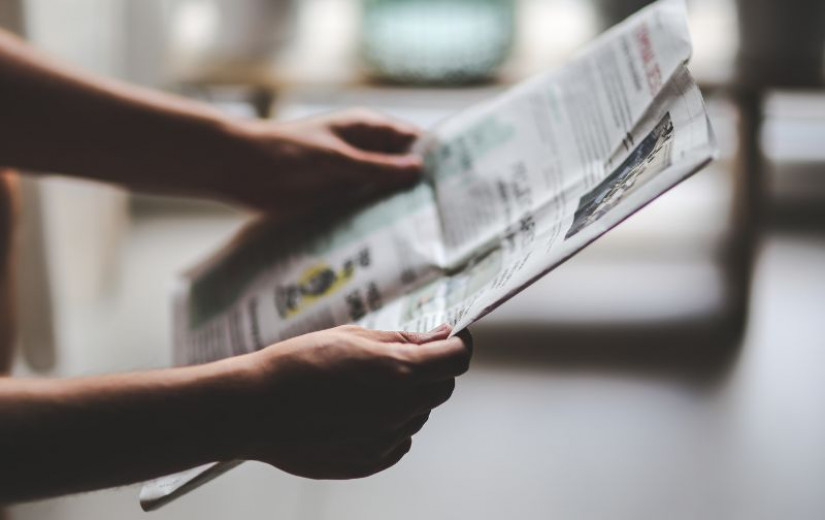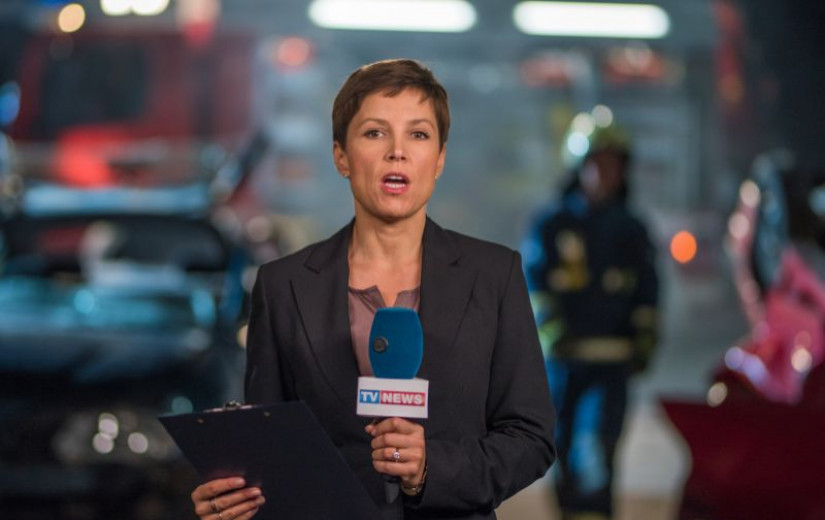

We can read Dustin Yellin’s work as an exercise in radical perspective—zooming in on the molecular scale of life, only to then leap outward across galaxies and speculative realities that transcend human intelligence. This expansion of consciousness, from the infinitesimal to the infinite, anchors his latest body of work, now on view in “If a bird’s nest is nature, what is a house?” at Almine Rech New York. Here, time and space collapse into dense, layered ecosystems where the past, present and future of humankind unfold simultaneously across a stage that veers between dystopian and utopian possibility.
Constructed from images clipped from print media and embedded in epoxy between stacked sheets of laminated glass, Yellin’s intricately choreographed scenes reflect the fluidity of existence and the relativity of human time. They suggest an entangled continuity of forces, beings and materials at a planetary scale. Humanoid figures perform recognizable gestures—laboring for survival or ego—while everything surrounding them pulses, germinates and evolves, propelled by the entropic drive of nature itself. These tableaux operate according to a logic far more expansive than ours, aligned with rhythms beyond the human grasp and attuned to the deeper temporalities of the universe.
“I think it comes down to how much value we place on our species, compared to the millions of years of time, the countless species that came before us, and all the potential forms of life that might exist in distant solar systems we’ve yet to discover,” Yellin tells Observer as we walk through the show. “It’s about the ability to zoom way out—to imagine not just eight billion humans, but eight billion suns, and a universe so vast we can barely comprehend it. I like this kind of mental exercise. You’re encouraging a way of thinking that moves between scales, zooming in on human intelligence and then zooming farther and farther out, beyond it.”

Yellin’s work begins with visions and hallucinations, yet remains deeply rooted in lived experience and the vast reservoir of knowledge and culture that humanity has amassed over centuries of evolution. Much of it, he explains, stems from nature and a persistent, curious observation of natural phenomena. “I’m always observing, always looking, whether it’s at geology or art history,” he says. “I spend a lot of time tweaking, studying, trying to assimilate everything I’m experiencing and seeing into the work. It’s almost as if the world itself is the archive, and I’m moving through it, collecting all the things that shape one’s existence.”
In this sense, his practice becomes an obsessive, almost compulsive attempt to archive and map the infinite nature of reality through the filter of consciousness—a quest to render that complexity visible and material, to celebrate its multiplicity, richness and irreducible intricacy. Yellin is engaged in a continuous effort to make sense of broader, cosmic and often unsettling truths. “It’s about how you break apart all the fixed parts and begin to see them as an orchestra, a complex composition of millions of distinct elements. Often, those individual components get shadowed by the perceived whole, obscured by the illusion of unity.”

Notably, what might at first seem like an intuitive plunge into the tides of personal and collective subconscious is, in fact, mediated through a meticulously premeditated staging of speculative futures that Yellin first sketches and designs in advance. As he explains, the collectible works currently on view at the gallery, given their contained scale, actually function for him more as maquettes for potential large-scale, immersive environments.
From this perspective, his Pioneer Works space can be understood as the most ambitious realization of Yellin’s vision: a living laboratory where imagined futures and creative regeneration become dynamic forces within a space that fuses disciplines, allowing divergent forms of knowledge and imagination to collide and coalesce.
What’s particularly striking is the digital aura that begins to emanate from these intensely analog, physically crafted maquettes. The effect arises from the saturation of color in each element and, above all, from the visual suspension of three-dimensional forms within what appears to be a liquid chamber that viewers encounter at a remove, separated by a transparent screen. The result is a subtle perceptual dissonance: something entirely handcrafted begins to feel like a simulation, unsettling the boundary between tactile reality and digital illusion, and complicating our relationship to this fictive yet uncannily speculative form of storytelling.
“It’s interesting because it’s the most analog thing—it’s just paint, paper, collage, found imagery. It has roots in Kurt Schwitters, Max Ernst, and those early collage traditions that are so deeply material, so tactile,” he says. “And yet, here we are in the year 2025, becoming an increasingly digital species. So the question is, how do you navigate—or even resist being caught—between those two worlds?”
Drawing from Einstein’s theory of relativity, philosophical notions of becoming and Jungian ideas of the collective unconscious, Yellin’s sculptural narrations assert that reality is no longer linear or singular, but relative, entangled and fluid—not only in physical terms but also through its digital double, an inherently mutable dimension. Within these capsules, everything converges in the possibility of simultaneity—worlds where the primordial past, the saturated present and a cosmically speculative future are compressed into a single spatial continuum.

This vision finds its most vivid expression in The Consequential Nature of the Simultaneous (2025), tucked into the gallery’s back room—a hallucinatory yet incisive continuum in collapse, where the epochs of civilization and planetary evolution converge. In this speculative tableau, an ancient Etruscan scene is mirrored against a chaotic cluster of humanoid figures wearing virtual-reality headsets, bumbling around NASA spacecraft and a particle accelerator. Many are already clambering onto a rocket, as if in desperate search of an escape route from the tangled loop of evolution, simulation and memory that defines human earthly existence.
At the same time, all of Yellin’s sculptural dioramas seem to undermine any lingering illusion of human supremacy. The human presence is rendered minuscule—microscopic figures, absorbed in mundane preoccupations, dwarfed by the ecosystems they inhabit. For Yellin, this act of speculative world-building becomes a means of imagining more harmonious ecologies, where nature emerges as an expansive, ever-evolving force that will continue its course regardless of human ambitions for control or permanence.
From these reflections arises the title “If a bird’s nest is nature, what is a house?”—a question that gestures toward the intricate entanglement of simultaneous modes of existential architecture, enacted by different species in their shared drive to endure. Yellin’s vision is neither fatalistic nor deterministic; rather, it acknowledges and embraces the idea that all things participate in a broader cyclical and interconnected order—one that surpasses the fate of any individual species.

All figures are suspended within an imaginative body of water, simulated through layered sheets of epoxy that, at moments, cascade like a waterfall, suggesting an unstoppable rush of transformation and evolution. “Bodies of water, falling water, the dynamics of fluid movement—these are elements I return to again and again,” explains Yellin. “They speak to transformation, to transmutation, to states of becoming and dissolving. There’s something in that constant motion that resonates with the themes I’m drawn to.”
Trapped within this ceaseless current of water and matter, the humanoids of The Habit of Nature (Study 2), also from 2025, discover a new possibility in the inversion of their world, that of fully surrendering their minor existence and participating in the flow of particles, energies and organic substances. A single-act drama, suspended in time and epoxy, becomes a tool to destabilize perception and an invitation to radically shift one’s viewpoint and reexamine what we accept as fixed, especially in the shadow of an impending ecological collapse.

Hanging on the wall, paintings and collages like Crack Painting 1 (2025) present relics and residues of past and present civilizations as they tumble into fractured rips in the fabric of reality—slipping toward an abyss, a collective nothingness or everythingness, a black hole of potential or annihilation. Meanwhile, the geological life of surrounding mineral and rock formations continues undisturbed, indifferent and cyclical, far more attuned to the cosmic intelligence of galaxies and stars. Aeological time stands in stark contrast to human time, which we measure in years, generations or centuries. As 18th-century geologist James Hutton observed, the Earth has “no vestige of a beginning, no prospect of an end.” Everything moves in circular motion, as in Seed 7 (2025), sustained by a constant process of energetic regeneration: a closed loop of becoming, dissolving and becoming again.
Yellin’s work is an ongoing inquiry into questions that are fundamentally unanswerable—an invitation to tune into other forms of intelligence while acknowledging the limitations of our senses and our minds when confronted with the vastness of cosmic truth.
Still, he believes in the power of the psychedelic to push perception past its habitual edges, drawing us closer to those elusive truths. “I think it’s a positive thing for society to be capable of shifting the way it perceives itself. If you can alter the collective mind’s perception through different modalities, then hopefully that opens up new ways of thinking and being,” he reflects, noting that as we grow more technologically dependent, it becomes increasingly urgent to re-center shared resources like air and water that are as vital as they are sacred. “The hope is that through expanded perception, we begin to value what sustains us, not just what connects us digitally.”
“It’s almost like mapping states of consciousness,” he adds, “as if you’re trying to freeze those otherwise fluid, shifting experiences—moments of illumination at the crossroads of past, present and future—arrest them just long enough so they can be seen, felt and contemplated.”
Dustin Yellin’s “If a bird’s nest is nature, what is a house?” is on view at Almine Rech through August 1, 2025.

More Arts interviews
-
TMA’s Adam Levine Is Making the Museum Model Smarter, Faster and Fairer
-
Angelo Sotira Wants to Set the Standard for Displaying Code-Based Art
-
Espoo Museum of Modern Art’s Krist Gruijthuijsen Rethinks Regional Curation
-
Quynh Pham On Two Decades of Galerie Quynh and Vietnam’s Evolving Art Scene
-
Ulrich Birkmaier On What Goes Into Restoring a Masterpiece








